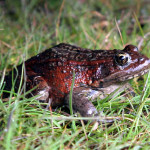A leap from the past: California Red-Legged Frogs
By Paul Stein
 Oh to be a frog in Calaveras County at fair time—celebrity doesn’t begin to define it. Each year during the third week in May these renowned amphibians take center stage at the county fair to reprise a time honored tradition: the celebrated frog jump of Calaveras County. Mark Twain gained national fame as an author for his famous short story: Jim Smiley and His Jumping Frog—the original title which started the custom.
Oh to be a frog in Calaveras County at fair time—celebrity doesn’t begin to define it. Each year during the third week in May these renowned amphibians take center stage at the county fair to reprise a time honored tradition: the celebrated frog jump of Calaveras County. Mark Twain gained national fame as an author for his famous short story: Jim Smiley and His Jumping Frog—the original title which started the custom.
The story goes that Angels Camp local Jim Smiley loved to bet, and would bet on anything—from the death of Parson Walker’s wife, to which of two birds would first fly off a perch. For a new twist, Smiley catches a frog and for three months he trains the frog (named Dan’l Webster) to jump, carrying him around in a box. One day, a wily stranger to town asks Smiley what he has in the box. Jim boasts he has a frog that can out jump any other frog in the county.
The stranger doesn’t see anything too special about Smiley’s frog and bets $40 that if he only had a frog he could beat him. Jim takes the bet, and hands his box to the stranger to hold while he runs off to catch another frog. But while Jim is gone, the stranger fills Dan’l with quail shot. Upon returning with another frog, the two men set their two frogs on the starting line and turn them loose. The stranger’s freshly caught frog jumps off, while Dan’l Webster doesn’t budge, too full of quail shot to do little more than squat.
Smiley was surprised and disgusted but pays off the stranger for the ill-conceived bet. He wonders though why Dan’l looks so puffy all of a sudden. He tips the frog upside down who coughs up handfuls of quail shot. Furious that he’d been swindled, Jim Smiley chases after the stranger who was long gone never to seen again. Twain’s classic tale began the historic tradition of jumping frogs in Calaveras County.
In recent years the frog jump event has gained additional notoriety because of the threatened status of the California Red-Legged frog by the US Fish & Wildlife Service. This frog is threatened and is protected by California law. The main cause of their population decline is habitat loss and destruction, but introduced predatory species such as American bullfrogs is probably the biggest factor. Bullfrogs are the species most often jockeyed at the international frog jump, but Giant African frogs and the Pigmy Tree frogs have also made an appearance.
Bullfrogs were originally introduced to the western United States in the late 1800’s to provide an additional source of frog legs after the 49er gold miners ate the California Red-Legged frogs (Rana draytonii) to near extinction. At that time gold miners and posh restaurants in San Francisco were gobbling up over 80,000 frogs per year. Bullfrogs have many traits that allow them to be perfect invaders outside their native range: female bullfrogs can lay more than 40,000 eggs and they can occupy a wide variety of habitats, including manmade and natural wetlands, streams, lakes, ponds and temporary pools.
So what species was most likely the celebrated jumping frog? Twain’s story was first published in 1865 and Bullfrogs weren’t introduced until around 1890, so most experts agree that if the story were true, Dan’l Webster would have been a California Red-Legged frog. The frog is aptly named as the abdomen and hind legs of adults are mostly red. Measuring up to 5 inches long, it is the largest native frog in the western United States and was once among the most abundant amphibians in California. Early accounts from gold miners panning for placer gold describe hundreds of these frogs diving into the water from along the banks as they approached. There seems little doubt that at one time this was a very prolific species in Calaveras County.
While the last known confirmed sighting of a red-legged frog in Calaveras County has been many years, the protected status of this frog and good habitat along the Pacific Coast is keeping this rare species from further decline. In March 2010, the US Fish and Wildlife Service announced 1,600,000 acres of protected land for the species throughout California. The largest population of the frog will be given protection on a 48-acre stretch of land in Placer County.
Although this species is estimated to have disappeared from 70% of its range, and is now only found in about 256 streams or drainages in 28 counties of California, the California Red-Legged frogs are still common along the coast, and the majority of their population declines are only in the Sierra Nevada.
As you watch the festivities of the frog jump this year, remember fondly the story about Jim Smiley and ol Dan’l. And if you ever catch a frog, be sure to check the legs…you may be holding a celebrity.
Paul Stein is a biologist with a long career in aquaculture. He was formerly Chief Deputy Director of the California Department of Fish & Wildlife. He can be reached at [email protected]
Side Bar:
If it’s your job to eat a frog, it’s best to do it first thing in the morning. And if it’s your job to eat two frogs, it’s best to eat the biggest one first.
Mark Twain



